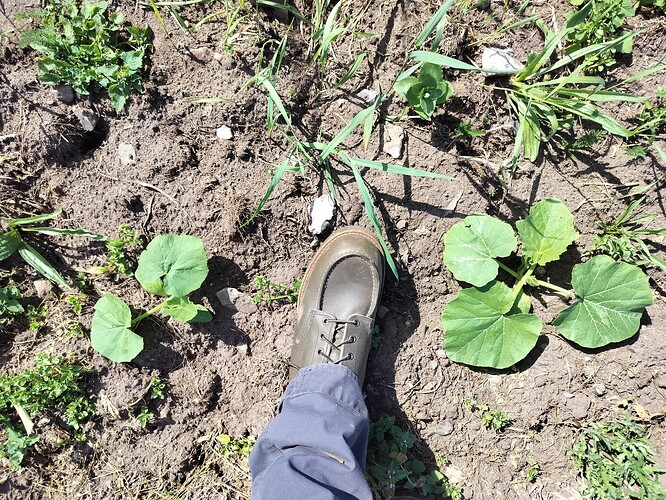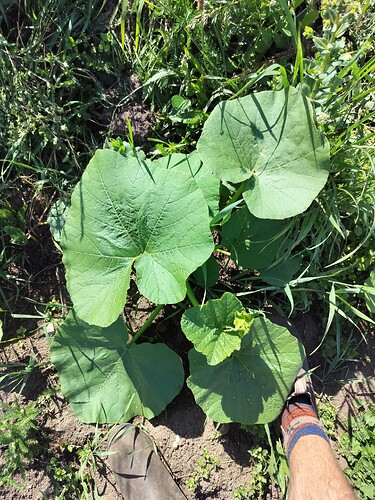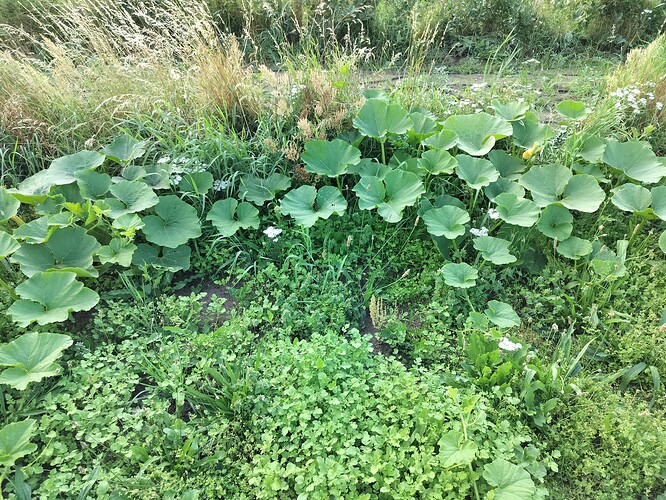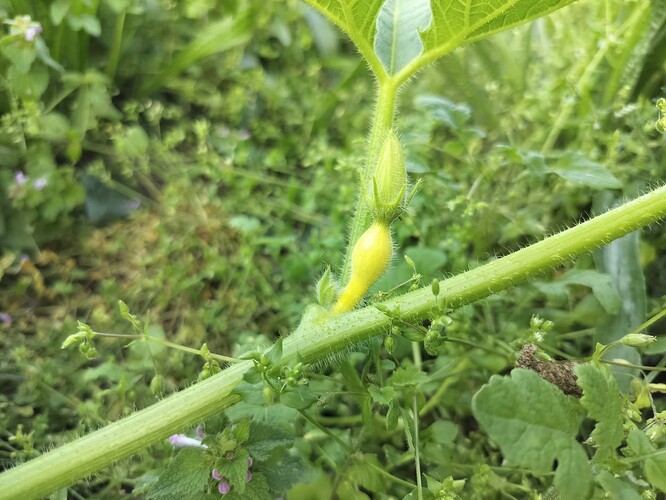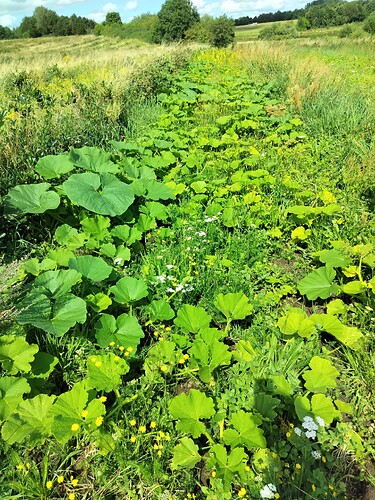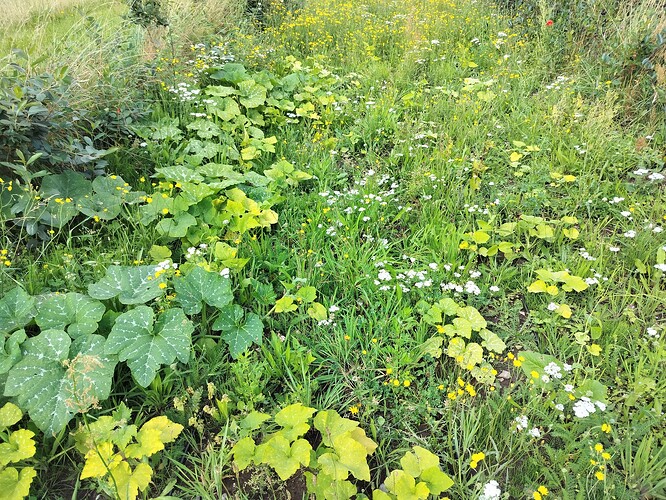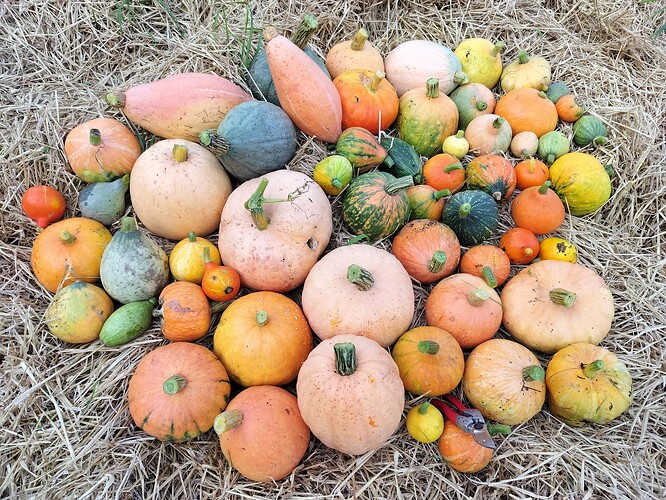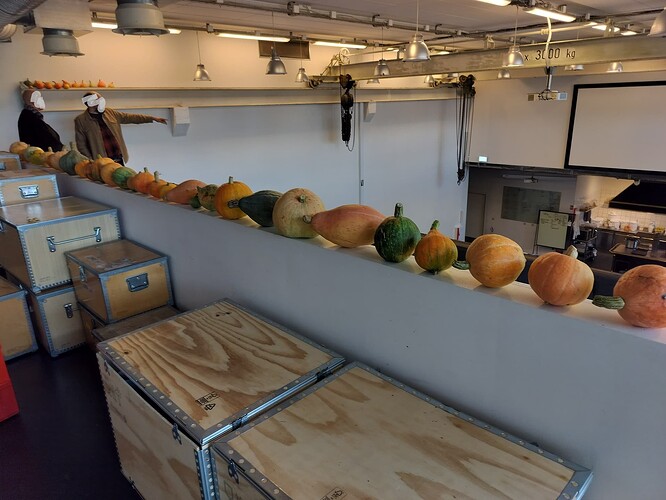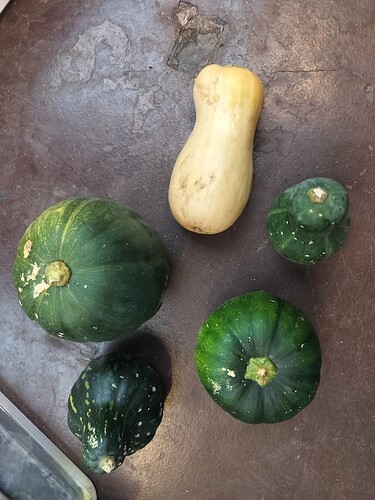I remember this exact same feeling, as I have tested some of my raw pepos this year
Grow report from 2024
This year the other gardener came back to run the school garden, which freed me up to teach more and begin a new school plot outside the city focused on breeding culinary landraces together with the chef students to grow food that meets the needs and desires of the kitchen
While establishing that project, we agreed that I could grow some pumpkin in the school garden. Here are some photos from this year.
I got the plants in the ground about 3-4 weeks later than I could. The seed were a mix of last years selected plants and some new seed.
Half of the plot is shaded by a large tree and only gets direct sun in the afternoon. Initially this made me a bit unhappy to grow Cucurbita there, but I figured that I would probably get some seed out of that would be better adapted to our sometimes very cloudy climate. And I would be curious to see if the plants could figure out solutions to this problem.
As you can see in the photo above, I welcome other plants and litter in my beds. Below is an image of a row of a named variety called Sweet dumpling that the other gardener wanted to grow. I love the flavor on it too, when I can get fruit from it, and it got good feedback at last years tasting.
As you can see, the plants struggle a bit. The leaves yellow and as the season progressed almost the whole bed died off as the neighboring beds with much more vigorous squash just filled in the vacant space.
Named variety growing in bare soil
Adaptive seed
One month later (mid July). Named variety marked white. To the right is C. moschata, a species that usually needs much more heat to grow well for me. And to the furthest right adaptive seed of C. pepo in even more shade.
Same day, genetically diverse seed of C. maxima grows vigorously.
I had some extra to plant out at the new school field outside the city. Since I only had half a growing season, I figured I would spend it just learning about the interactions between the site, the plants and the soil. Probably the latest planting of squash in my country (around two or two and half months later than normally planted) in mid July!
I had zero watering there, not even at planting time, and would only visit the site 4-5 times this season. If I could get any viable seed from this season there, it would have really useful traits.
Around one month later (mid august), I’m surprised to see how well the plants grew with zero input. Close up of some of the better looking plants:
Lots of competition here:
One month later (early september), a drought of around 1,5 month has severely stressed the plants. One zucchini-type pepo has set fruit.
Back at the school, we have access to water. One squash has trailed 3-4 beds and climbed two meters into a nearby apple tree where it set fruit.
Since we manage the school garden to allow the chef students to come and harvest themselves, they inevitably take some of the squash too without knowing to save seed from them. I harvested the rest this week.
The big yellow one is the one that hanged in the apple tree, so the students couldn’t see it. Clearly I got much less from the beds that were shaded, but was happy to see three pretty warted pepos with ripe fruit from the most shaded spot.
Did a tasting and selection workshop at the speaking event with @Joseph_Lofthouse and posted some pictures from it here. Participants had donated squash for the tasting, incl. the school. In total 12 very different squash. Only three got good enough review to grow the seed from next year. One really stood out which I think came from @Logan (an aromatic banana/hubbard shaped hybrid typical of the ones Joseph grows). None of the squash I had grown this year made the cut. I will save seed from one of them anyway, because they grew really well under the conditions (lots of shade in the spot I had this year). Most of the seed came from your generous donation @ThomasPicard, so that might have value as feedback on your seed. Healthy growers with bland taste! Did you select for flavor yet or did you focus on growing and keeping qualities? I’m happy to send you next generation seed, by the way.
Hi Malte and all, thanks for posting. The seeds from me were f1 seeds, grown in 2022, so first year grex with no active selection in the field or in kitchen whatsoever. This grex was assembled around keeping qualities only, as writen in seed catalogues… But of course if they said those 25 original varieties were bland I would not have taken them… But you know sellers tend to find qualities in all their products ![]()
So now in 2024 (or what I brought to Antibes -and even if I added many new strains and sources in 2024, and even if I had huge losses in 2023-), it’s third year so theoretically the start of heavy selection, started around early vigor in direct sowing (95% culling), which I followed by marking on earliness… then now, as I have 400 kilos of maximas there, and what you write makes me wonder if I would not get rid of earliness markings to concentrate on taste only, as it could be the priority at this stage, if I got your overview right. But because I have brought in so much new varieties this year I wonder… either considering this still as a grex, maybe simply sorting by earliness (which was partially meant for scandinavians but if it’s mostly bland it seems like there is no point in that…) or directly go to heavy selection on taste. Also I need to balance it with my enormous selection pressure on vigor for going to direct sow post cover crops, which needs many many seeds… Anyway, you got the infos for the seeds of the 2022 stage.
If you’ve selected for earliness, that is really great, i thought people down south could maybe have two crops a year then, that will speed up breeding so they can add great tasting ones all the time and get great tasting early ones in a couple of years.
But if you chuck out early ones over ones that do taste great and have a hybrid swarm that isn’t so early you get great tasting ones of which some will be early and then can select for great tasting early ones.
So in a way it’s the same. Except that you can speed up breeding, two generations in one season only with early ones.
Imagine next year is a hot one, you start early(hardiness selection) with your early selection and then select the best tasting early ones of those and replant those together in a mixed planting with seeds of your best tasting ones (maybe even of everybody’s best tasting ones) of this year, maybe by next year you’ll have what you’re looking for.
Then people down south could all be hard selecting for best tasting early double seasoners.
I’m having a run of squash tasting with chef students for the fruit that has been storing up well. I’m reading up on the references pushed by @ThomasPicard esp. the Brent Loy material and now I understand the grower’s paradox. I’m turning around and redefining my selection criteria on that basis.
The students and chefs all want to eat squash and pumpking late October and early November (and then for some reason the interest wanes). I think the market taught them to behave like this. It certainly seems that the culinary reasons don’t hold up. I now understand why many squash taste better later in season and why those that are made to give a good early crop might not have as extraordinary good eating qualities.
My new goals are looking more like this, chronologically in the rough order they’ll be on the menu:
- Late summer / early fall: Long-necked Zuccheta-landrace (immature moschata). Still same idea.
- Winter pepo (acorn, delicata). Smaller sizes and can still be eaten among the first storage cucurbits.
- Mid-winter mature moschata
- Long-storage maxima
This time (late February) the fruit that came out as clear top scorers were a sweet dumpling type acorn-pepo, a delicata pepo and kabocha-type. Some fruits that continue to divide testers are the ones that don’t have common squash taste and are not sweet but have different aromas like cucumber and melon - most tasters dislike this flavor profile, but there are very often some that really like it. It goes to show that people like different things. I try to keep some of these seeds because of it and don’t want to get rid of these differences. Still not quite sure which direction to take it in. Perhaps isolate those kinds of fruits and see if they can be more pronounced? A feedback I also got from a chef was that they generally find squash boring! The good ones are sweet and fitting for desserts, but too little aroma to make interesting savory food. This is something to work on!
I find the work you’re doing alongside the culinary school fascinating!
After many family and friends taste tests, we found many squash varieties are sweet but bland. They lack more refined/complex flavours.
Our favourites are the medium-sweet chestnutty types like Marina di Chioggia, Potimarron, Blue Kuri. They also have a beautiful texture (not too watery or dry).
2 posts were merged into an existing topic: Zuchetta landrace: Very long-necked unripe moschata (tromboncino-type)
This year I’m growing all annuals at a new plot. Spring was mostly getting the field ready, installing irrigation and carrying lots and lots of stones. Early to mid June I could direct sow Cucurbita. Posting some pictures from the last month or so.
Maxima
I’m growing them in about 60 m2 this year and testing out ways to include students into the work. Next year I plan to reserve on part of the field just for Cucurbita - if everything goes well this year up to 500 m2 perhaps.
Here they are beginning of July with some of the bigger plants highlighted
Mid July
Late July. One of the early June direct sown plants are running wild
First fruit are forming
Early August. I’m in the field about once a week, so I’m happy the plants can compete with the weeds and are starting to fill in well. I don’t have time for much weeding.
One plant has without contest the biggest leaves of them all. Probably the biggest leaves I’ve seen on a Maxima I’ve grown myself dwarfing the other plants. Wonder if it will be one of those huge fruits - is there a relationship?
Moschata
Moschata growing much more slowly for me. I think the plants missed most of this summer’s strong heat, which came pretty early. It’s been raining a lot the last month instead. I’m noticing that the best plants all grow along the edge of the bed which is a pattern in a big part of the field, which might be either from water-logging (the edge draining better) or because of raking off so much grass turf to get started in spring and throwing all the nutrients in the edge.
2025
Results for maxima this year.
I grew these on 60 m2 and then a separate bed with seed that were more difficult to get hold of, e.g. because it had American origin or there were few seeds. Interestingly, my “prioritized bed” spectactularly failed and only produced one tiny Hubbard-type fruit. The bed were I used my own seed combined with seed from our own European community grew much better. Lots of genetics went into this: Sweet Meat, Lauras grex, Chloé’s, Hugo’s, Vivi’s Sweet Fall x Pink Banana, Thomas’ Good, Early and Excellent Keepers and more.
I should have booked the transporter wagon and not brought a small car to move that day. I know I like these kinds of pictures, so I thought you might too:
I let them mature inside in the school’s Green Laboratory as an exhibition until we will do tastings and select seed for next year.
2025
Results for regular moschata this year. Direct seeded on 30 m2 relatively nutrient poor soil about two times selective weeding over the season.
I also had high hopes for American seeds, but it was a big disappointment..
I remember you were late , is that correct? I was late with Moschata and most are just as dark green as yours. Nice selection for earliness at least.
Amazing photos and diversity ![]()
I sowed them 12th of June this year. I could have seeded them earlier, at least two weeks and possibly 3-4 weeks to select for earlier growing types.
















